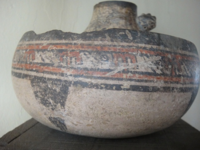
The Ancient footprints of Acahualinca (Spanish pronunciation: [akawaˈliŋka]; Spanish: Huellas de Acahualinca) exist in Managua, Nicaragua near the southern shore of Lake Managua. The region was once called "El Cauce".[1] The tracks are fossil Late Holocene human footprints left behind in volcanic ash and mud, which solidified about 2,120±120 years ago, shortly after the group of up to 15 people passed by.[2]
It is sometimes reported that the people were running to escape from a volcanic explosion, but the distance between the footprints indicates a walking gait.[3] Fossilized footprints of several animals are also present, but the fact that they intersect the human footprints shows they were not traveling with the people.[4]
YouTube Encyclopedic
-
1/3Views:5791 0842 515
-
Excavating ancient footprints in Namibia
-
Mazatzin Speaks about His Journey to Nicaragua
-
BU researchers use new software to uncover ancient footprints at Laetoli
Transcription
>>Matthew Bennett: Hello from the Namib sandsea in Southern Africa, an international team of scientists of which staff from Bournemouth University are part, is currently excavating and recording ancient footprints preserved in rivermuds, baked hard by the sun and buried for thousand of years beneath large sand dunes. As the dunes migrate across this fossilised surface, human and animal prints are exposed through a few years at a time, allowing them to be recorded and analysed. Like these two thousand year old hyena prints forming this beautiful trail or this fantastic human footprint. The preservation is so good you can actually the skin and texture and the calluses on the soles of the foot that made this print over two thousand years ago The prints are in filled by a layer of sand cemented hard by salt and need careful excervation before they are recorded and analysed and preserved using an optical laser scanner. This work forms part of a large nerc grant, based collaboratively between Bournemouth University and Liverpool University, which is exploring the evolution of human locomotion. Sites like this one in Namibia are helping the team to understand and infer interpert much older footprint sites elsewhere in Africa left by our ancient ancestors.
Scientific analysis of the footprints
In 1874, construction workers discovered the footprints. The United States medical doctor and archaeological collector, Earl Flint, brought the footprints to the attention of the international science community and media in 1884.[5]
The Carnegie Institution of Washington began the first scientific analysis and excavations of the area in 1941 and 1942. They also constructed a museum and a building to protect the footprints.[6]
Work was continued by Joaquín Matilló, Allan L. Bryan and Jorge Espinosa in the 1960s and 1970s. Allan L. Bryan, from the University of Alberta, used radiocarbon dating to determine the age of soil humates, from a buried soil directly underlying the footprints, to 5,945±145 radiocarbon years Before Present.[3] Based upon this date, he estimated that the footprints dated to about 5,000 Before Present. But, later dating of the volcanic deposits in which they occur, known as the Masaya Triple Layer, demonstrated that the fossil tracks are only about 2,120 ± 120 years old.[2] In 1978, the Nicaraguan researcher Jorge Espinosa continued the excavation near the termination of the original excavation. He uncovered more footprints at a depth of 4 meters.[4] The track is believed to continue further.[7]
Specimens of these footprints can be viewed at both the Peabody Museum of Archaeology at Harvard University and the United States National Museum.[8]
Acahualinca Museum
The "Museo Sitio Huellas de Acahualinca" is located at west of Managua, in the eponymous Acahualinca town. The museum was founded in 1953 by Nicaraguan scientist Leonor Martínez, later in 1989, was rescued, restored and fitted out with the support of "ASDI" and the Historical Museum of Sweden. In addition to footprints, the museum features a small collection of pottery and other items of archaeological interest from several sites in Nicaragua. Previously there were stone tools and a skull from León Viejo.[4]
Gallery
See also
- Eve's footprint — footprints of a single female found at Langebaan, South Africa in 1995, dating to approximately 117,000 years ago.
- Happisburgh footprints — early Pleistocene fossilized hominid footprints found in a sediment layer on a beach at Happisburgh in Norfolk, England, dating to more than 800,000 years ago,
- Ileret — footprints of Homo erectus found at Ileret, Northern Kenya, dating to approximately 1.5 million years ago.
- Laetoli footprints — a line of hominid footprints, discovered at Laetoli, Tanzania by Mary Leakey in 1976, dating to approximately 3.6 million years ago.
- List of fossil sites (with link directory)
- List of hominina (hominid) fossils (with images)
References
- ^ Brinton, D.G. (1887). "On an ancient human footprint from Nicaragua". Am. Phil. Soc. Proc. 24 (126): 437–444. JSTOR 983095.
- ^ a b Schmincke HU, Kutterolf S, Perez W, Rausch J, Freundt A, Strauch W (July 2009). "Walking through volcanic mud: the 2,100-year-old Acahualinca footprints (Nicaragua)" (PDF). Bulletin of Volcanology. 51 (5): 479–493. Bibcode:2009BVol...71..479S. doi:10.1007/s00445-008-0235-9. S2CID 43686540.
- ^ a b Bryan, Alan L (1973). "New light on ancient Nicaraguan footprints". Archaeology. 26 (2): 146–147.
- ^ a b c "Acahualinca Footprints Museum, Tourist Attractions, Culture". Nicaragua.com. Retrieved 2007-10-28.
- ^ Flint, Earl (1884). "Human footprints in Nicaragua". Am. Antiquarian. 6: 112–114.
Flint, Earl (1885). "Human footprints in Nicaragua". Am. Antiquarian. 7: 156–158. - ^ Carnegie Institution of Washington. "Geologic observations on the ancient human footprints near Managua, Nicaragua". Contributions to American Anthropology and History. 11 (52).
- ^ "Ancient footprints of Acahualinca". ViaNica. Retrieved 2007-10-28.
- ^ Brown, Roland W (January 1947). "Fossil plants and human footprints in Nicaragua". Journal of Paleontology. 21 (1): 38–40. JSTOR 1299291.
External links
- Human Timeline (Interactive) – Smithsonian, National Museum of Natural History (August 2016).


